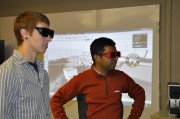ACADEMIA
MU Unveils 3-D Visual Immersion Laboratory
New “iLab” will allow undergraduate students to design projects in a 3-D environment
One of the most difficult tasks architects and interior designers face when designing buildings and rooms is visualizing exactly what their projects will look like when they are finished. Now, the University of Missouri architectural studies department has developed the Immersive Visualization Lab (iLab) to help students visualize their designs more accurately. Bimal Balakrishnan, an assistant professor of architectural studies in MU College of Human Environmental Sciences, says the iLab will be one of few labs in the country to allow undergraduate students to get hands-on experience using immersive 3-D technology to complete and test their designs as part of their design studio curriculum.
“Most university immersion labs are reserved primarily for graduate students to use for research purposes,” Balakrishnan said. “While the MU iLab will be used for research, it will also serve as an excellent teaching and experiential tool for undergraduate students.”
The MU iLab incorporates three large high-definition projection screens aligned side-by-side to create one continuous, horizontal viewing screen. Wearing special “active shutter” glasses, students are able to view their computer-generated architectural and interior designs on the screen in 3-D. The immersive effect of the large screen gives students the sensation of standing inside the buildings they are designing. Balakrishnan says this virtual reality effect can be a valuable tool for architectural designers.
“Visualizing true characteristics in a three-dimensional space is one of the biggest challenges design students face,” Balakrishnan said. “This is because design mediums, like models and floor plans, place the students outside of what they are designing. The iLab will not only allow students to experience their designs from the inside, but they also will be able to view their designs in a much larger scale and experiment with different textures and styles in real time.”{modal url=http://www.supercomputingonline.com/images/balakrishnan-ilab-glasses-2.jpg} {/modal}
{/modal}
The iLab also will feature a design collaboration environment, which will allow students to work together on design projects seamlessly. This environment will let students connect computers and project designs on an interactive “smart board,” making it much easier to work on elaborate design projects in groups. Balakrishnan says building costs for the iLab were cut in half by designing and assembling the $85,000 iLab in-house.
“We saved on cost by developing the infrastructure ourselves,” Balakrishnan said. “We also are saving on cost for maintenance and service by using easily replaceable components when they become obsolete. We are not tied to any specific vendor, so we can easily adapt the iLab as the technology develops.”
Balakrishnan acknowledges the advice and support of faculty and staff from the Immersive Environments Lab (IEL) and the iCon lab from Penn State University. He says the iLab is part of a continuum of a desktop-based virtual reality approach which began at Penn State.

